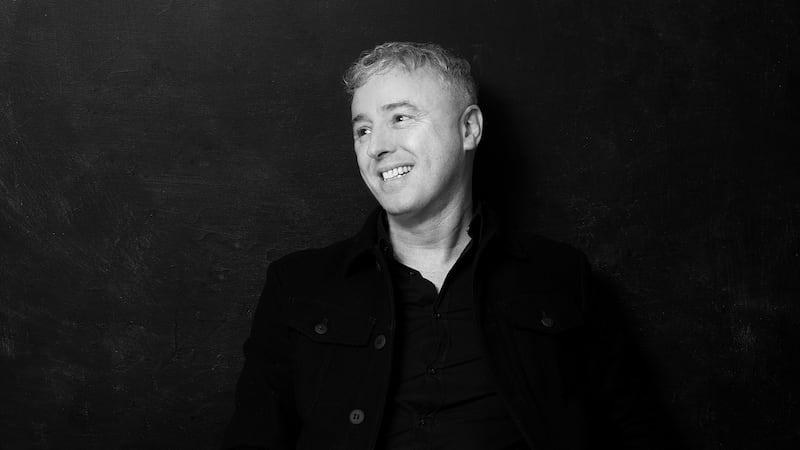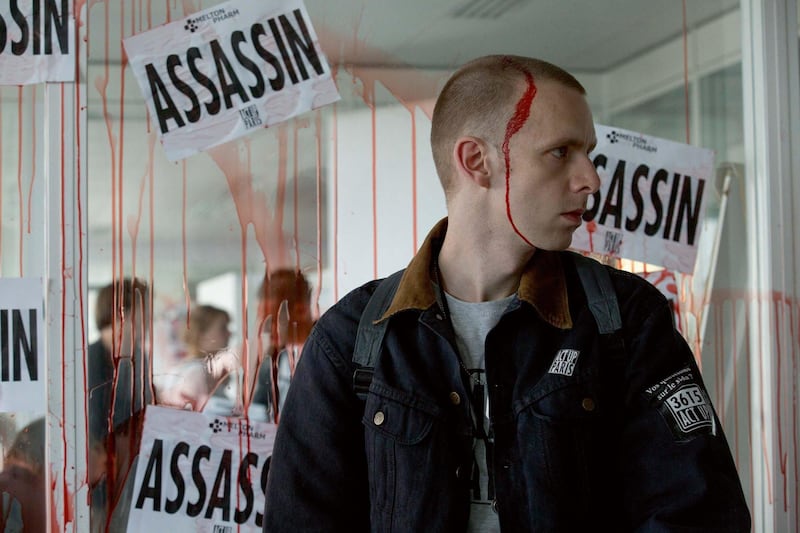Robin Campillo was a 20-year-old film student when the first images of the Aids crisis started to appear in French newspapers. These pictures included the famous before-and-after shots of Ken Ramsauer, who, in 1983, became the first person with Aids to be the subjepect of an American network news special. Ramsauer's shocking appearance is revisited, more than three decades later, in 120 BPM, Campillo's award-winning dramatisation of Act Up Paris, the Aids-activist collective of which he was a member in the early 1990s.
“His name was Kenny,” one of the film’s characters explains to his lover. “He looked like a freak. I’d never seen a gay couple in a magazine before. Except it was to say homosexuals were going to die.”
“This was a guy who wanted to show people what someone with HIV and Aids looked like,” says Campillo. “But in the end he was exploited by the media like he was a monster. He wanted to warn people and they used those images. That was awful. I saw those pictures when I was 21 and I was so afraid at that time.”
That early hysteria around the virus dramatically impacted upon the young Campillo. Having completed his studies at the French film school IDHEC in Paris (since renamed La Fémis) in 1986, Campillo took a job as a video editor for the current-affairs desk of French state TV channel France 3. He first encountered Act Up while editing news segments about the organisation.

“I was 20 in 1982 when it started,” says the Moroccan-born French filmmaker. “I was really afraid of what was going on because I was a young gay guy, reading all these articles saying that most of the gay men were going to die from this disease, and all these horrible stories. For 10 years, I was not living my own life. I was so afraid of what was going on that I stopped having sex. I was overprotecting. It was because of the death of my first boyfriend – my first love, I should say – I became angry. It was a problem for me that gays were targeted by the press, saying that we were all going to die. And at the same time, there was no communication about the others, warning drug users, prostitutes, other groups. So I came to Act Up out of anger.”
Act Up originated as a New York-based coalition that, during the 1980s, took on Ronald Reagan and Big Pharma. Their pioneering campaign style, as expertly chronicled by David France's 2012 documentary How to Survive a Plague, led to the creation of dozens of American and international chapters.
As 120 BPM opens, Act Up Paris is a dynamic organisation committed to the same attention-grabbing activism as its US progenitor. Their exuberant activism sees water balloons filled with fake blood, colourful street parades, and office invasions. Add an erotically charged romance between veteran radical Sean (Nahuel Perez Biscayart) and HIV-negative newcomer Nathan, and Arnaud Rebotini's thumping house soundtrack, and 120 BPM becomes the most exhilarating, dynamic film ever made about a generational tragedy.
If we wanted to survive, it was not just because we wanted a job and a life
People were dying, says the 55-year-old filmmaker, best known for his collaborations with the director Laurent Cantet (including Time Out, Heading South and the Palme d'Or-winning The Class). But that tragedy was often obscured by a sense of jubilation.
"If we wanted to survive, it was not just because we wanted a job and a life," says Campillo. "It's because we were very good at having fun, at partying, at having sex, at clubbing, at all these things that were important to us. It was so unfair that we were dying so young. And while it was not true that all people were listening to house music at that moment, for most of us, it was the soundtrack to that time. It is an urgent, emotional, nostalgic music for us. Didier Lestrade, the first president of Act Up Paris, was a music critic and a house DJ."
In 2000 Lestrade, along with several other scene DJs, founded the monthly KABP dance party, an event that would continue for four years and would leave a lasting mark on France’s influential electro music scene.
“At the end, the music has evolved so it’s like a gospel,” says Campillo. “I asked the actors not to look at each other when they are dancing. It’s like when you are in the darkness in the cinema. You are in a crowd but you are on your own. I love this idea, this contradiction between a collective action, and at the same time, being alone. Cinemas and clubs are very close in this kind of experience.”
To date, there have been several well-regarded documentary films that deal with the Aids crisis, including How to Survive a Plague (2012), United in Anger: A History of ACT UP (2012) and Larry Kramer in Love and Anger (2015).
The wildly ambitious 120 BPM is often closer in tone and scope to these films than other fictional features (especially Hollywood's award-friendly Philadelphia and The Dallas Buyers' Club) that have touched on the same subject matter.
While the film pivots around a central romance, its Altmanesque sprawl of characters ensures that Act Up is the real protagonist, rather than any one person. The organisation is constantly, vibrantly in flux, as the perennially exasperated coordinator Sophie (Adèle Haenel) seeks to contain the militants down the back, overly eager agitators, and a contentious leader (Antoine Reinartz).
Often, in the best possible sense, it can feel like a more exciting variation on documentarian Fred Wiseman’s institutional studies.
“I just tried to create a structure and perspective that, as you say, was institutional,” nods Campillo. “It is people in a room with a theatre and no windows exchanging ideas and forging a new political discourse. And at the same time, I really tried to make things not only realistic, but to have parts of the film that are like a dream. It was a difficult process. In France we have an expression – river film or broad flow film – where we move between characters and stories. That was complicated and at the same time very emotional. I was crying as I wrote. I didn’t want to make something like a documentary or a docudrama. I just put all my memories in it. I was recording everything in my mind and hoping to one day do something with the material. I didn’t try to find the meaning or the shape.”
I wanted to show all the things that you hide under the carpet, as we say in France
Against the quasi-fantasy sequences – including the Seine running red – Campillo’s film is characterised by unvarnished sequences of sex and death. A late wake scene depicts the poignantly realistic treatment of a dead body.
“I wanted to show all the things that you hide under the carpet, as we say in France,” says the writer-director. “So people have sex in my film. In a film about Aids, you have to show all these things. When someone dies, for any reason, you have to stay with the body for a long time, especially when it’s at two o’ clock in the morning. Everyone wants to go to the room and see the body and after it becomes irrelevant because you cannot do anything. You don’t cry. It’s a very weird emotion, like a dream or nightmare, like you are disconnected from what is happening. That specific feeling of anaesthesia was important. But there are beautiful, tender moments around death, too. And I wanted to show those.”
Having previously shot the features The Returned (2004) and Eastern Boys (2013) on film, Campillo's switch to digital added to the spontaneity of 120 BPM.
“I did my first film like a Hitchcock film,” he laughs. “It was on 35mm. so when you hear the clap, everybody stops breathing, and you have to do the most perfect take. But with the digital cameras, I can have three cameras. So I don’t need very long days. From the first day on the set, we were changing things as we went along.”
The staffing took place in a similarly unorthodox spirit. Argentine actor Nahuel Pérez Biscayart was cast as the firebrand Sean. Arnaud Valois, who had quit acting several years earlier to become a masseuse, was chosen to play Nathan.
“So I found an Argentinian actor who is very baroque and I love this because he had to play overstated political character until the time when he gets sick he has no more distance from the disease. And the other actor had got tired of waiting for directors to call and became a masseuse. And I loved that because the way he was touching Sean in the film was tender, but at the same time, like medical care.”

I can't help but notice that the generally jolly Campillo has a particular glint in his eye while discussing the period when 120 BPM is set. I wonder if he feels that, despite all the attached tragedy, queer culture has lost something that burned especially brightly during the Act Up crusades.
"It's an interesting question because you have to imagine that when I was 18, in front of my family, I was still in the closet, but I was feeling very strong because I was like Jean Genet! "
He laughs: “I was an outcast, I was so proud of that. But when the epidemic started I realised that we needed to be considered by society. And that our love – our couples – must be recognised by the state. For instance, when my first love died, I was nothing to him legally. So, as gays and lesbians – we did not say LGBTQ back then, and I prefer LGBTQ – there has always been a tension between being different and needing recognition. Act Up happened mid-way between 1968 and the struggle for gay marriage. It’s not like here. It was a hard struggle. Because the people which were against gay marriage did the same actions we did 20 years ago with Act Up. Now we’re another form of institution.”
- 120 BPM is out now











